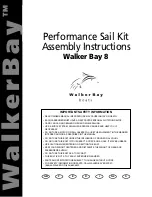
IB131021EN
Page
xxvii
Effective Mar 2018
cycle. Once the capacitors discharge to accomplish the
close action, they immediately begin to recharge which
takes approximately 15 seconds.
5-3.1
ELECTRICAL OPERATION
The VCP-WL circuit breaker can be charged, opened, and
closed electrically within the range of all control voltages
listed in IEEE C37.06-2009. In the event that control power
is lost, the circuit breaker will not be capable of performing
an electrical open operation. An optional undervoltage
relay is available and can be mounted directly to the
control wiring in the VCP-WL circuit breaker’s chassis.
The undervoltage relay will automatically send a signal to
trip the circuit breaker in the event that control power is
lost.
5-3.2
MANUAL OPERATION
While the circuit breaker is powered on, it can be manually
closed and opened through the use of the front mounted
green "Push to Close" and red "Push to Open" push
buttons (Figure
3-5
). In the event that control power is lost,
the circuit breaker is capable of performing a manual
OPEN operation. The circuit breaker is manually opened
by pulling the “EMERGENCY OPEN” handle (Figure
3-5
)
away from the circuit breaker until the mechanism and
ultimately the vacuum interrupters open.
5-3.3
TRIP FREE OPERATION
When the emergency open handle is pulled, the local
“Push to Open” push button is depressed, or the open floor
tripper is lifted, any attempt to close the circuit breaker will
be prevented.
5-3.4
ANTI-PUMP FEATURE
All VCP-WL circuit breakers have a standard anti-pump
feature. If the circuit breaker is open, the breaker only
accepts one attempt to re-close when the close
command continues uninterrupted.
5-3.5
CHARGING
Figure
3-3
is a schematic view of the electrical charging
circuit. The charging circuit is comprised of a set of power
supplies, a controller, and a capacitor bank.
The power supplies accept a voltage input from the
customer through pins 1 & 24 of the secondary connection.
The power supplies accept any stored energy voltage
within the range of the control voltages listed in IEEE
C37.06-2009. The power supplies output 48VDC, which is
used to provide power to the controller.
The controller contains internal circuitry to accept voltage
from the power supplies and charges a set of capacitors
which store energy to open and close the circuit breaker.
The controller has an internal capacitor which stores
energy for a tripping operation. The controller charges an
external capacitor bank which stores energy for a closing
operation. The external “closing” capacitor bank is
comprised of four 39,000uF capacitors which are charged
to 95VDC. When the circuit breaker is powered on, the
“closing” capacitor bank reaches a full charge within 25
seconds. After a closing operation, the “closing” capacitor
bank fully recharges within 15 seconds.
The VCP-WL breaker has a “Charged Indication Light”
which is wired into the “Stored Energy Indication” circuit
which is wired to pins 2 & 23 of the secondary connection.
The “Charged Indication Light” is visible from the front of
the circuit breaker, which illuminates when the “closing”
capacitor bank is charged and the breaker is ready to
close.
5-3.6
CLOSING OPERATION
Figures
3-3, 3-4, 3-5
, show all components involved in a
closing operation. A close signal can be sent to the
controller by applying an input voltage to pins 4 & 21 of the
secondary connection that is in accordance with the control
voltages listed in IEEE C37.06-2009, by depressing the
green “Push to Close” button on the front of the circuit
breaker, or by lifting the Close Floor Tripper.
Once a close signal is sent to the controller, the controller
will discharge the stored energy from the “closing”
capacitor bank into the closing coil of the electromagnetic
actuator. Once the close coil of the electromagnetic
actuator is energized, the armature inside of the actuator
will rapidly move and latch closed against the permanent
magnet inside of the actuator. The armature of the
actuator is connected to the top and bottom output plates
by the yoke. When the armature is moved to the closed
position, the output plates are driven to the right when
looking at the front of the circuit breaker. The top and
bottom output plates each have three identical cam blocks
that drive the cross members and drive rod assembly
toward the rear of the breaker during a closing operation.
The drive rod assembly is connected to the bell cranks on
each pole unit. The bell cranks are also connected to the
moving stem of the vacuum interrupter on each phase.
When the drive rod assembly is driven toward the rear of
the circuit breaker during a closing operation, the bell
cranks rotate counter clockwise and the vacuum
interrupters are driven to the closed position.














































